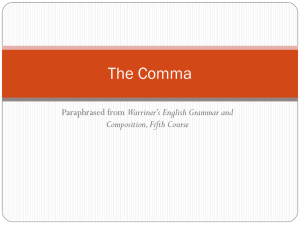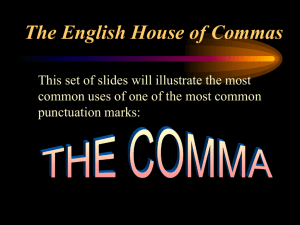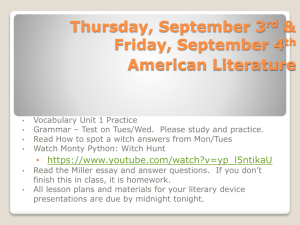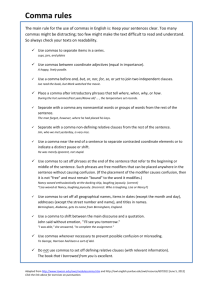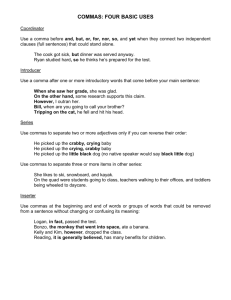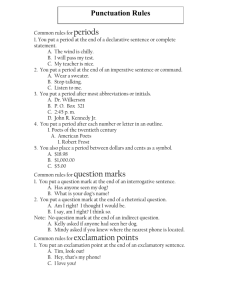E105_wk5
advertisement
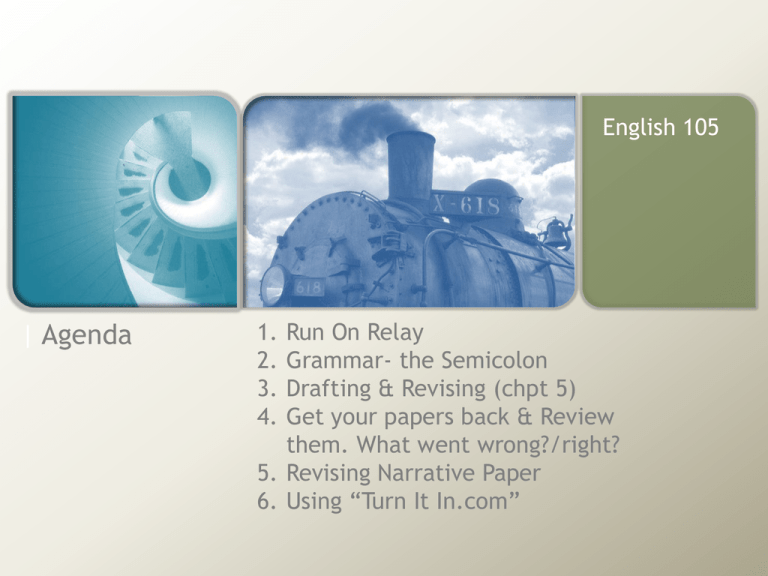
English 105 | Agenda 1. 2. 3. 4. Run On Relay Grammar- the Semicolon Drafting & Revising (chpt 5) Get your papers back & Review them. What went wrong?/right? 5. Revising Narrative Paper 6. Using “Turn It In.com” Review: Run ON • 2 or more independent clauses (whole sentences) combined incorrectly. – Too many ANDS (goal 1-2 “and”s per sentence) – Fused • Jammed together with no punctuation – Comma Splice • Jammed together with just a comma (need comma conjunction!!!) Game! • Run-On Race • 4-5 Teams: Each team runs this like a relay – Identify Sentence, Fragment, or Run On – Fix the Fragments/Run-Ons – I will send you back to your group if the answer is wrong. – Form a “batting order” – the first person cannot go again until every person on the team has been up. • Every 5 questions you complete, your race car will move forward. • First to the end wins! If you finish early: Review Description Essay Results and Get training on TurnItIn.com! • http://www.turnitin.com – click on Training Commas, Colons, and Semicolons Oh my! Commas , • Commas clarify meaning • Set sentence meter (breaths) for readers. • Use commas to separate items in a list, date, or address. – I can’t believe you went to Disneyland, Six Flags, and Universal Studios all in one day! – Please buy mustard, onions and chili for the hotdogs. – We went to Belgrade, Nebraska, on July 1, 2011. Use of the Comma (cont.) • Use commas after longer introductory phrases and clauses. Introductory phrase – After we completed our to all three parks, we fell into a dead sleep for 12 hours. Usually starts with a Preposition, adverb, or Conjunction Comma use (cont.) • Use commas after shorter introductory phrases and clauses if necessary to avoid confusion. – To Sam,Mickey Mickey is stranger no stranger. To Sam is no – To chili, hotdogs are a natural accompaniment. Comma use (cont.) • Use commas to set off nonrestrictive (nonessential) elements from the rest of a sentence (also caused appositive phrases). These phrases just give more information. – Mickey Mouse’s main squeeze, Minnie, is one cute mouse. – I can’t believe, he groaned silently, I ate so many hotdogs. - NOTE: It can also be correct to use parentheses ( ) instead of commas in unnecessary, information adding phrases! Comma Use (cont.) • Use commas to separate coordinate modifiers (descriptive modifiers of equal rank). – To determine whether modifiers are coordinate or not, insert “and” between them. If the sentence still makes sense, the comma is required. – Disneyland is a fun, expensive place. (coordinate) – He eats only roasted Hebrew National hotdogs. (not coordinate) Commas (cont.) • Use commas to separate two independent clauses joined by a coordinating conjunction. – We knew it would be a long day, but we decided to go to all three amusement parks anyway. – He roasted five hotdogs at the bonfire, and he also set a hay bale on fire. Colons : • Colons announce. They add dramatic flourishes that introduce lists, quotations, complete sentences, and dialogue. • Use a colon to introduce a quotation longer than one sentence introducesWhen a quotation inintroduce the next you use a colon to a complete sentence, capitalize the first paragraph. word. – The attendant looked straight at us and said: “This ride is not for sissies. It is a high speed thrill ride. You will yell. You will scream. You will cover your eyes and beg for your mommy. If you don’t think you can handle it, get out of line now!” Use of the Colon • To introduce the text of questions and answers (e.g. in interviews). – Q: What was your favorite Disneyland ride? – A: Pirates of the Caribbean • Use colons to show times. – We finished our theme park tour at 1:15 a.m. • Use colons to show citations. – Ecclesiastes 3:1-8 tells us that there is a season for everything. Semicolons ; • A semicolon is not quite a comma, not quite a period. It is a break in thought, but not a complete stop… more like an elongated pause. • Use a semicolon to connect independent clauses and avoid run-on sentences or comma splices. – We went to Disneyland; we had a great time. – He ate six hotdogs; he also got a stomach ache. Semicolons (cont.) • Use a semicolon to separate items in a list that also include commas. – Donald Duck brought his favorite lunch: a sandwich, chips, and crackers; his nephews, Huey, Dewey, and Luey; and his favorite girl Daisy – In order to win the contest, John starved himself for two days, Monday and Tuesday; wore extra large clothes, size 42 jeans and XXL shirt; and drank castor oil. Teacher Evaluation • Please take a moment to evaluate this class. – Anonymous – Place in the “turn in here” folder when complete • I will leave the room Drafting, Revising: Creative and Critical Thinking Chapter 5 pg 95 Revision – what is it! • Just because you wrote it doesn’t mean its done. • Revision isn’t editing and proofreading, its reconsidering audience, purpose, tone, etc. • Its not punishment or busywork. • No part of your work is sacred or permanent – you can save multiple drafts! • Everyone must revise. At all levels of writing. Homework • Final Draft of Narrative – due via email – May turn it in to TurnItIn.com as well. • Journal 3 – topic “How do my instructors view me” – MLA format • Grammar log for Descriptive Essay – if required

